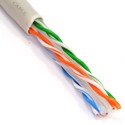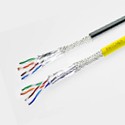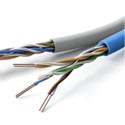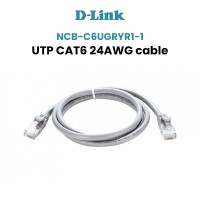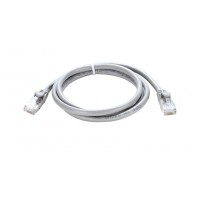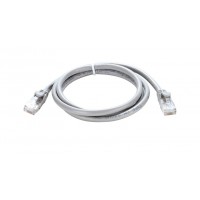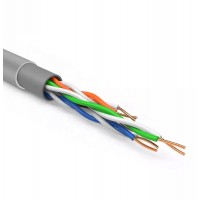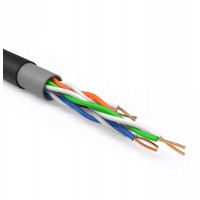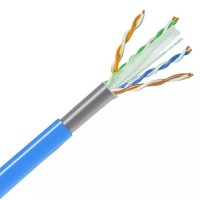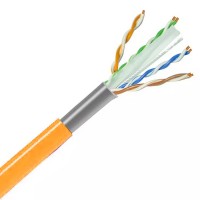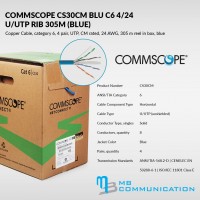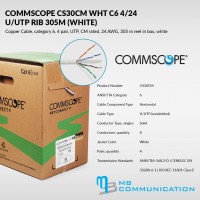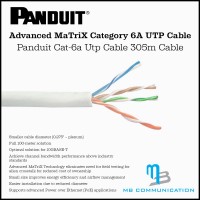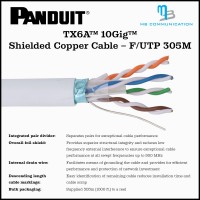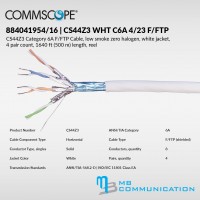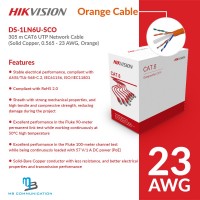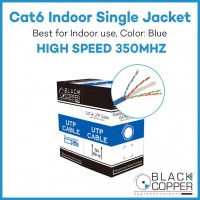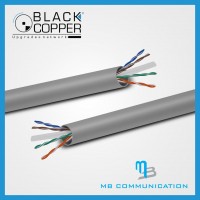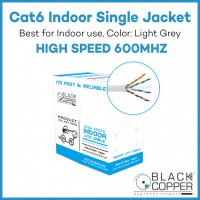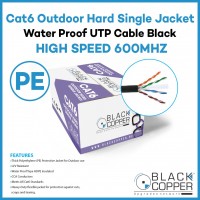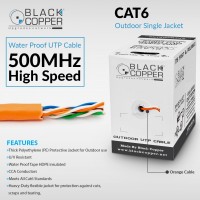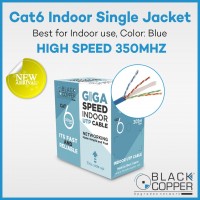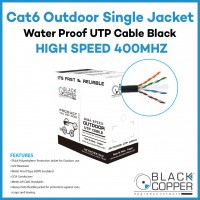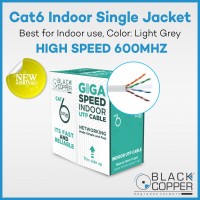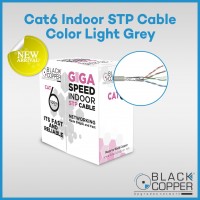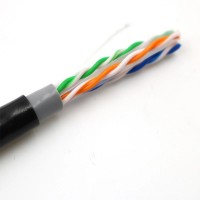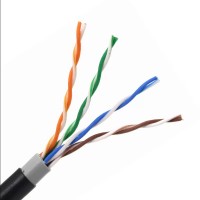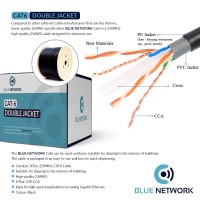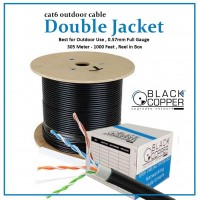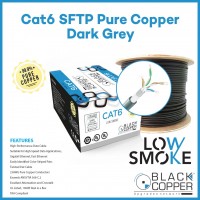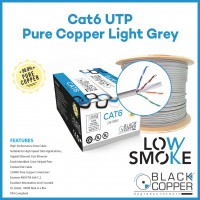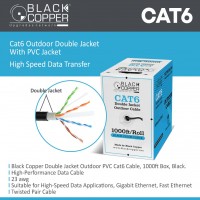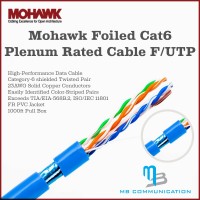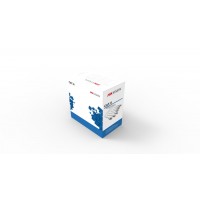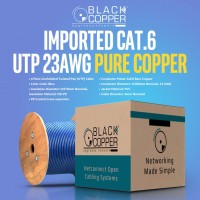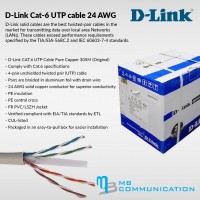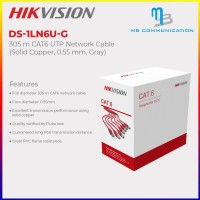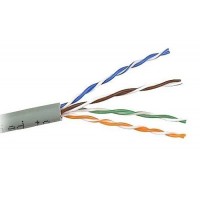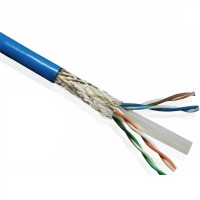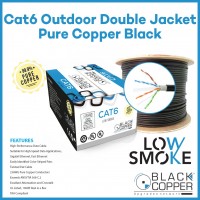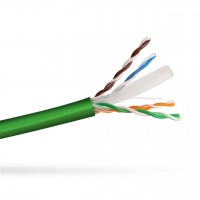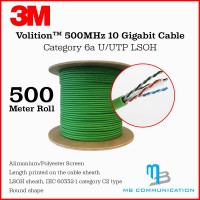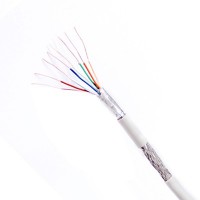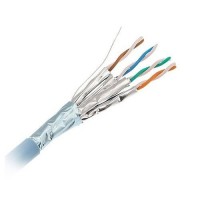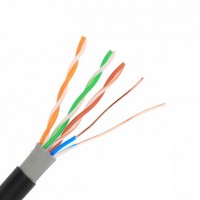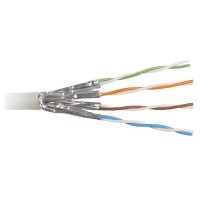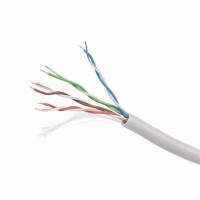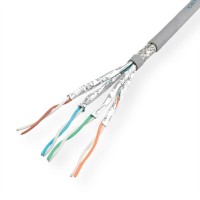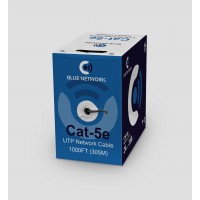No products
RJ45 Cable
New products
-

BlackCopper BC-EGP-10G015-Z
Transform Your Business with BlackCopper BC-EGP-10G015-Z Dual Screen POS...
Rs 0
Catalog
RJ45 Cable: The Backbone of Your Network
In the digital age, connectivity is paramount. Whether you're running a bustling office, a cozy home network, or anything in between, a reliable and robust network connection is essential. And at the heart of that connection lies the humble, yet indispensable, RJ45 cable.
What is an RJ45 Cable?
An RJ45...
RJ45 Cable: The Backbone of Your Network
In the digital age, connectivity is paramount. Whether you're running a bustling office, a cozy home network, or anything in between, a reliable and robust network connection is essential. And at the heart of that connection lies the humble, yet indispensable, RJ45 cable.
What is an RJ45 Cable?
An RJ45 cable, also known as an Ethernet cable, is a twisted-pair cable used to connect devices on a local area network (LAN). It uses the RJ-45 connector, a standard 8-pin modular connector, to establish physical connections between network devices like computers, routers, switches, and more.
Types of RJ45 Cables
RJ45 cables come in various types, each designed for different purposes and speeds:
- Cat5e: The most common type, offering speeds up to 1 Gigabit per second (Gbps).
- Cat6: Supports speeds up to 10 Gbps and offers improved performance for high-bandwidth applications.
- Cat6a: An enhanced version of Cat6, capable of handling speeds up to 10 Gbps over longer distances.
- Cat7: The fastest type, supporting speeds up to 100 Gbps, typically used in high-performance data centers.
Understanding Cable Specifications
When choosing an RJ45 cable, it's important to consider its specifications:
- Category: As mentioned above, the cable category determines its speed capabilities.
- Shielding: Some cables come with shielding to reduce interference and improve signal quality. Common types include:
- UTP (Unshielded Twisted Pair): The most basic type, without any shielding.
- STP (Shielded Twisted Pair): Offers increased protection against interference.
- FTP (Foiled Twisted Pair): Uses a foil layer around the wires for shielding.
- Length: RJ45 cables come in various lengths, from short patch cables to longer runs for connecting devices across rooms or buildings.
RJ45 Cable Connections
Connecting an RJ45 cable is straightforward:
- Locate the RJ45 port on your device.
- Align the RJ45 connector with the port and gently push it in until it clicks securely.
- Repeat the process for the other end of the cable.
Choosing the Right RJ45 Cable
Selecting the right RJ45 cable depends on your specific needs and the applications you plan to use it for. Consider the following factors:
- Speed requirements: Determine the maximum speed needed for your network.
- Cable length: Choose a cable length that suits your setup.
- Shielding: Consider the level of shielding required based on your environment and potential interference.
- Quality: Opt for cables from reputable manufacturers to ensure durability and performance.
MB Communication: Your Trusted Source for Networking Solutions
MB Communication is a leading provider of networking solutions, offering a wide range of RJ45 cables and other networking products. Our commitment to quality and customer satisfaction ensures that you get the right solution for your needs.
Whether you're setting up a home network, expanding your business network, or connecting critical infrastructure, trust MB Communication to provide the reliable and high-performance RJ45 cables you need for seamless connectivity.
For more information about our products and services, please visit our website or contact us directly.
RJ45 Cable There are 46 products.
Subcategories
-
Cat6 Cable
Cat6 Ethernet Cables: The Backbone of High-Speed Networks
In today's digital world, high-speed internet connectivity is paramount. Whether you're running a bustling office, a demanding gaming setup, or simply streaming your favorite shows, reliable and fast internet is essential. Cat6 Ethernet cables are the unsung heroes behind this seamless connectivity, delivering lightning-fast data transfer speeds and unwavering performance.
Cat6 cables are the go-to choice for demanding network applications, supporting data transfer rates up to 1 Gigabit per second (Gbps). They are a significant upgrade from older Cat5 cables, offering enhanced bandwidth, reduced crosstalk, and improved noise immunity.
What Makes Cat6 Cables Superior?
Cat6 cables boast several key advantages that make them ideal for today's high-speed networking needs:
- Higher Bandwidth: Cat6 cables can handle data transfer rates up to 1 Gbps, significantly faster than Cat5 cables.
- Improved Signal Quality: With a higher twist rate and thicker conductors, Cat6 cables minimize signal interference and ensure clear data transmission.
- Reduced Crosstalk: The improved construction of Cat6 cables reduces crosstalk, a phenomenon that can distort signals and reduce performance.
- Greater Distance Support: Cat6 cables can support longer cable runs than Cat5 cables, making them suitable for larger installations.
- Backward Compatibility: Cat6 cables are backward compatible with older Cat5 and Cat5e devices.
Choosing the Right Cat6 Cable
With a wide array of Cat6 cables available, choosing the right one for your needs can be overwhelming. Here are some factors to consider:
- Cable Length: Determine the length of the cable you need based on your network setup.
- Cable Type: Cat6 cables are available in various types, including solid-core, stranded, and shielded options. Consider the specific application and environmental factors.
- Cable Performance: Look for cables with a higher data transfer rate (1 Gbps) and a low crosstalk rating.
- Brand Reputation: Opt for Cat6 cables from reputable brands like BlackCopper, Commscope, 3M, and Panduit, known for their quality and reliability.
Cat6 Cables: The Foundation of High-Performance Networking
Cat6 Ethernet cables are a cornerstone of modern networking, providing reliable, high-speed data transfer for various applications. Whether you're a home user, a business owner, or a tech enthusiast, investing in quality Cat6 cables will ensure a seamless and efficient networking experience. Remember to choose cables from trusted brands like BlackCopper, Commscope, 3M, and Panduit to guarantee the best performance and longevity.
For more information on Cat6 cables and networking solutions, reach out to MB Communication.
-
Cat7 Cable
Cat7 Cable: The Ultimate Guide to High-Speed Networking
In the ever-evolving world of technology, high-speed internet connectivity is essential for both personal and professional use. Cat7 cable, the latest generation of Ethernet cable, offers exceptional performance and reliability, making it the ideal choice for demanding networking needs. This comprehensive guide will delve into the intricacies of Cat7 cable, exploring its features, benefits, applications, and everything you need to know to make an informed decision.
What is Cat7 Cable?
Cat7 cable stands for Category 7 cable and is a type of twisted-pair Ethernet cable designed to support high-speed data transmission rates. It is the most advanced type of Ethernet cable available, offering significant improvements over previous generations, including Cat5e and Cat6. Cat7 cable is characterized by its increased bandwidth, reduced signal interference, and superior shielding, allowing for faster data transfer and more reliable network connections.
Key Features of Cat7 Cable
- Enhanced Bandwidth: Cat7 cable supports data transfer rates up to 10 Gbps, providing a significant speed advantage over earlier generations.
- Improved Shielding: With a four-pair shielded design, Cat7 cable offers superior protection against electromagnetic interference (EMI) and radio frequency interference (RFI), ensuring signal integrity and reducing data transmission errors.
- Reduced Crosstalk: The twisted-pair design and shielding minimize crosstalk, the interference between adjacent wires in the cable, resulting in clearer signals and improved performance.
- Backward Compatibility: While Cat7 cable is optimized for 10 Gbps networks, it is backward compatible with earlier Ethernet standards, including Cat5e and Cat6.
Benefits of Using Cat7 Cable
Choosing Cat7 cable for your network offers several advantages, including:
- Faster Data Transfers: With its high bandwidth, Cat7 cable enables lightning-fast data transfers, ideal for demanding applications like online gaming, video streaming, and large file transfers.
- Increased Reliability: The superior shielding of Cat7 cable protects against signal interference, ensuring reliable network connections even in environments with high electromagnetic noise.
- Improved Network Performance: The reduced crosstalk and enhanced signal integrity of Cat7 cable contribute to smoother network performance, reducing lag and buffering.
- Future-Proofing: Cat7 cable's high bandwidth and advanced features make it a future-proof investment, ensuring your network can handle the demands of emerging technologies.
Applications of Cat7 Cable
Cat7 cable is ideal for a wide range of applications, including:
- High-Performance Data Centers: Cat7 cable's high bandwidth and reliability are essential for demanding data center environments.
- Home Theater Systems: Cat7 cable ensures smooth and uninterrupted video streaming for home theater systems.
- Gaming Networks: The fast data transfer rates of Cat7 cable eliminate lag, providing a seamless gaming experience.
- Video Conferencing: Cat7 cable ensures clear and reliable video conferencing, eliminating interruptions and delays.
Choosing the Right Cat7 Cable
When selecting Cat7 cable for your network, consider factors such as:
- Cable Length: Cat7 cable is available in various lengths, choose a length that meets your specific needs.
- Connector Type: Ensure the cable has the appropriate connectors (RJ-45) for your network devices.
- Shielding: Choose a cable with adequate shielding to protect against interference in your environment.
- Brand Reputation: Opt for reputable brands known for quality and reliability.
Conclusion
Cat7 cable is the ultimate solution for high-speed networking, offering unparalleled performance, reliability, and future-proofing. With its enhanced bandwidth, superior shielding, and backward compatibility, Cat7 cable ensures seamless and efficient data transmission for demanding applications. For those seeking the best possible network experience, Cat7 cable is the clear choice.
When choosing Cat7 cable, remember to consider the factors mentioned above and select a cable that meets your specific requirements. Investing in Cat7 cable is an investment in a high-performance, reliable, and future-proof network that will enhance your digital experience.
-
Cat5e Cable
Cat5e Cables: The Backbone of Your Network
In the digital age, a robust and reliable network is essential for businesses and individuals alike. Cat5e cables, the workhorses of network connectivity, play a crucial role in transmitting data across your network. Understanding the nuances of Cat5e cables can help you make informed choices and optimize your network performance. This guide will delve into the world of Cat5e cables, exploring their features, applications, and how they compare to other cable types.
What is a Cat5e Cable?
Cat5e, short for Category 5 Enhanced, is a twisted-pair cable used for Ethernet networking. It's an upgrade from the earlier Cat5 standard, boasting improved performance and enhanced capabilities. Cat5e cables are capable of supporting data transfer rates of up to 1 Gigabit per second (Gbps), making them suitable for various network needs, including:
- High-speed internet connections
- Connecting computers to network switches and routers
- Setting up home theater systems
- Building network infrastructure for small businesses
Key Features of Cat5e Cables
- Twisted-Pair Design: Cat5e cables consist of four twisted pairs of wires, with each pair carrying data signals. The twisting helps reduce interference between pairs, ensuring signal integrity.
- Shielding: While not always present, some Cat5e cables include shielding to further minimize electromagnetic interference. This is particularly important in environments with high levels of electrical noise.
- Connector Type: Cat5e cables typically terminate with RJ-45 connectors, the standard connector used for Ethernet connections.
- Data Transfer Speed: Cat5e cables are designed to support data transfer speeds up to 1 Gbps, making them suitable for most home and small business applications.
- Frequency Bandwidth: Cat5e cables have a frequency bandwidth of up to 100 MHz, allowing for efficient transmission of high-frequency data signals.
Cat5e vs. Cat6 Cables
Cat6 cables represent an advancement over Cat5e, offering even higher performance and faster data transfer speeds. While both Cat5e and Cat6 cables are suitable for gigabit Ethernet, Cat6 cables have a higher bandwidth (up to 250 MHz) and can support data transfer rates of up to 10 Gbps. If you're planning for future-proofing your network and require high-speed connections for demanding applications like video editing or high-resolution gaming, Cat6 cables may be the better choice. However, for standard home and small business networks, Cat5e cables remain a cost-effective and reliable option.
Choosing the Right Cat5e Cable
When selecting Cat5e cables, consider factors like:
- Cable Length: The length of the cable determines signal strength and performance. Longer cable runs can lead to signal attenuation, so choose a cable length that suits your application.
- Cable Quality: Look for cables made from high-quality materials and manufactured to industry standards.
- Shielding: If your environment has high levels of electromagnetic interference, consider shielded Cat5e cables for better signal integrity.
- Connector Type: Ensure the connectors are compatible with your network devices.
Popular Cat5e Cable Brands
Several reputable brands offer high-quality Cat5e cables. Some of the most trusted names in the industry include:
- Ubiquiti
- Blue Network
- MB Communication
- Belkin
- Monoprice
- AmazonBasics
Conclusion
Cat5e cables remain a popular choice for network connectivity due to their reliability, cost-effectiveness, and ability to support gigabit Ethernet speeds. By understanding their features, applications, and differences from other cable types, you can choose the best Cat5e cables for your specific needs. Whether you're setting up a home network, expanding your business infrastructure, or simply upgrading your existing cabling, Cat5e cables provide a reliable foundation for high-speed connectivity.
-
Dlink NCB-C6UGRYR1-1
4 Unshielded Twisted Pair (UTP) Cable Metal Conductor: made of solid copper Color Code: gray Patch Cord Cable Length 1 Meter Maximum Data Transmission: 1 Gbps 24 AWG Conductor Size Insulation Material: HD-PE Cable Protective Jacket Material: PVC UL94V-0
Rs 300In Stock -
Dlink NCB-C6UGRYR1-2
• 4 Install the Unshielded Twisted Pair (UTP) Cable• Metal Conductor: made of solid copper• Color Code: gray• Patch Cord Cable Length of 2 Meters• Maximum Data Transmission: 1 Gbps• 24 AWG Conductor Size• Insulation Material: HD-PE• Cable Protective Jacket Material: PVC UL94V-0
Rs 370In Stock -
Dlink NCB-C6UGRYR1-3
• 4 Unshielded Twisted Pair (UTP) Cable• Metal Conductor: made of solid copper• Color Code: gray• Patch Cord Cable Length of 3 Meters• Maximum Data Transmission: 1 Gbps• 24 AWG Conductor Size• Insulation Material: HD-PE• Cable Protective Jacket Material: PVC UL94V-0
Rs 420In Stock -
Blue Network Cat-5e UTP Double Jacket Grey
Cat 5e UTP Double Jacket 24 AWG 305m Mixing Copper High quality UTP/unshielded cable, "twisted pair" type, 5e category from the reputable Blue Network, for use in internal network installations
Rs 6,720In Stock -
Blue Network Cat-5e UTP Double Jacket Black
Cat5e UTP Double Jacket 24 AWG 305m Mixing Copper High quality UTP/unshielded cable, "twisted pair" type, 5e category from the reputable Blue Network, for use in internal network installations
Rs 6,720In Stock -
Blue Network Cat-5e UTP Double Jacket Blue
Cat5e UTP Double Jacket 24 AWG 305m Mixing Copper High quality UTP/unshielded cable, "twisted pair" type, 5e category from the reputable Blue Network, for use in internal network installations
Rs 6,720In Stock -
Blue Network Cat-5e UTP Double Jacket Orange
Cat5e UTP Double Jacket 24 AWG 305m Mixed Copper High quality UTP/unshielded cable, "twisted pair" type, 5e category from the reputable Blue Network, for use in internal network installations
Rs 6,720In Stock -
Commscope CS30CM BLU C6 4/24 U/UTP
1427071-2 | CS30CM BLU C6 4/24 U/UTP RIB 305M Copper Cable, category 6, 4 pair, UTP, CM rated, 24 AWG, 305 m reel in box, blue
Rs 36,400In Stock -
Commscope CS30CM WHT C6 4/24 U/UTP
1427071-2 | CS30CM WHT C6 4/24 U/UTP RIB 305M Copper Cable, category 6, 4 pair, UTP, CM rated, 24 AWG, 305 m reel in box, white
Rs 42,800In Stock -
Panduit Cat6a UTP Cable
TX6A™ 10Gig™ UTP Copper Cabling System Category 6A cable shall be constructed of 23 AWG copper conductors, twisted in pairs and separated by an integrated pair separator
Rs 44,200In Stock -
-
Commscope CS44Z3
884041954/16 | CS44Z3 WHT C6A 4/23 F/FTP CS44Z3 Category 6A F/FTP Cable, low smoke zero halogen, white jacket, 4 pair count, 1640 ft (500 m) length, reel
Rs 78,000In Stock -
Hikvision DS-1LN6U-SC0
305 m CAT6 UTP Network Cable (Solid Copper, 0.55 mm, Orange) Stable electrical performance, compliant with ANSI/TIA-568-C.2, IEC61156, ISO/IEC11801 Compliant with RoHS 2.0 Sheath with strong mechanical properties, and high tensile and compressive strength, reducing damage during the project
Rs 35,880In Stock -
Black Copper Cat-6 UTP Single Jacket (Blue)
Black Copper Cat-6 UTP Indoor Single Jacket Cable Roll 350mhz (305 Meter) Colour Blue
Rs 4,900Out of stock -
Black Copper Cat-6 UTP Dark Grey
Black Copper Cat-6 UTP Cable Best for Indoor/Outdoor use Speed,400Mhz, Color Dark Grey
Rs 5,900Out of stock -
Black Copper Cat-6 UTP Single Jacket...
Black Copper Cat-6 UTP Indoor Single Jacket Cable Roll 600MHz (305 Meter) Colour Light Grey
Rs 5,900Out of stock -
Black Copper Cat-6 UTP PE Single Jacket
Black Copper CAT-6 Outdoor Hard Single Jacket PE UTP Waterproof Cable Speed Rating 600Mhz, Length 305 Meter Color Black
Rs 6,300Out of stock -
Black Copper Cat-6 UTP Single Jacket Orange
Black Copper CAT-6 Outdoor Single Jacket Cable UTP Waterproof Orange Speed Rating 500Mhz, Length 305 Meter
Rs 6,450Out of stock -
Black Copper Cat-6 UTP Blue
Black Copper Cat-6 UTP Indoor Single Jacket Cable Roll 350MHz (305 Meter) Colour Blue
Rs 6,450Out of stock -
Black Copper Cat-6 UTP Single Jacket Black
Black Copper CAT-6 Outdoor Single Jacket Cable UTP Waterproof Black Speed Rating 400Mhz, Length 305 Meter
Rs 6,450Out of stock -
Black Copper Cat-6 UTP Light Grey
Black Copper Cat-6 UTP Indoor Single Jacket Cable Roll 600mhz (305 Meter) Colour Light Grey
Rs 6,500Out of stock -
-
Skyline UTP Cat6 Double Jacket
Skyline UTP Cat6 Bare Copper Outdoor PVC PE Double Jacket Skyline Use this 4-pair UTP cable for just about anything under the sun! At the fast speed of Cat6 power, this cable is perfect for audio, video, or any type of data transfer. Weatherproof. This particular Cat6 cable is constructed with a protective Double Jacket layer.
Rs 7,800Out of stock -
Finetech UTP Cat-6 Double Jacket
Cat6 Outdoor Cable, 1000ft (305m), PE and PVC Double Jackets, 23AWG, 550MHz, Unshielded (UTP), Bulk Ethernet Cable, Black
Rs 8,740Out of stock -
Blue Network UTP Cat6 Double Jacket
Cat6 UTP Outdoor Double Jacket lan cable CCA 23awg 4pr 305m 1000ft Conductor OD: 0.56mm Insulation: HDPE Conductor Material: CCA Shield: UTP(Unshielded Twisted Pair) Jacket color: Black Jacket material: PVC+PE Package: 305m/roll, 1roll/carton;
Rs 8,740Out of stock -
Black Copper Cat6 Double Jacket Outdoor Cable
Black Copper Cat-6 Outdoor Cable (305 Meter) Color Black
Rs 9,500Out of stock -
Black Copper CAT-6 SFTP Pure Copper
Black Copper CAT6 SFTP Pure Copper 23AWG (1000 ft) Color Dark Grey
Rs 14,500Out of stock -
Black Copper Cat-6 UTP Pure Copper Cable
Cat-6 Cable Roll - Black Copper (305 Meter) Pure Copper Colour Light Grey
Rs 16,500Out of stock -
Black Copper Cat-6 Double Jacket (Black)
Black Copper Cat-6 Double Jacket Outdoor Cable (305 Meter) Colour Black
Rs 16,810Out of stock -
Mohawk CAT 6 F/UTP Cable
Mohawk Foiled Cat6 Plenum Rated Cable F/UTP Our Category 6 foiled twisted pair (F/UTP) cable is tested to 550 MHz and is third-party verified to Category 6. Now with FlexWeb® construction, the filler isolates the pairs throughout the length of the cable, while providing a round installer-friendly cable.
Rs 20,000Out of stock -
Hikvision DS-1LN6-UE-W
CAT6 Network Cables Full diameter 305 m CAT6 network cable Core diameter: 0.53mm Excellent transmission performance using solid copper Quality verified by Fluke test Guaranteed long PoE transmission distance Great PVC flame resistance.
Rs 24,000Out of stock -
Black Copper Cat6 23AWG Pure Copper
Imported CAT6 UTP Cable (Pure Copper 23AWG) CAT6 4Pair Unshield Twisted Pair, CM rated, 23AWG, 305m/box, Blue
Rs 35,360Out of stock -
D-Link Cat-6 UTP Pure Copper
D-Link Cat-6 UTP Pure Copper 24 AWG D-Link solid cables are the best twisted-pair cables in the market for transmitting data over local area Networks (LANs). These cables exceed performance requirements specified by the TIA/EIA-568C.2 and IEC 60603-7-4 standards.
Rs 36,338Out of stock -
Hikvision DS-1LN6U-G
305 m CAT6 UTP Network Cable (Solid Copper, 0.55 mm, Gray) Popular Full diameter 305 m CAT6 network cable Core diameter: 0.55mm Excellent transmission performance using solid copper Quality verified by Fluke test Guaranteed long PoE transmission distance Great PVC flame resistance.
Rs 39,130Out of stock -
AMP UTP Cat6 Pure Copper
Category 6 UTP Cable, low smoke zero halogen, gray jacket, 4 pair count, 1000 ft (305 m) length
Rs 41,787Out of stock -
Belden Cat-6 SFTP Pure Copper
Belden GRYDKPRL BELDEN CAT6 SFTP LAN Cables are designed for your LAN networking needs, supports Gigabit Ethernet (1000 Base-T) standard and backwards compatible. Operates at a bandwidth up to 250 Mhz.
Rs 50,750Out of stock -
Black Copper Cat-6 Double Jacket Pure Copper
Black Copper CAT6 Outdoor Double Jacket Pure Copper Cable CAT6 Communication Cable Outdoor Double Jacket 23AWG Pure Copper(1000ft) Color Black
Rs 51,360Out of stock -
3M VOL-6UL4-305
3M Volition Cat6 UTP Pure Copper Belonging to the 3M™ Volition™ Network Solutions, this 350 MHz UTP Category 6 cable will deliver the best performance when used with the 3M™ RJ45 K6 jacks, to give highest margins over Category 6 / TIA/EIA 568 and ISO 11801 and EN 50173 Class E standards.
Rs 55,120Out of stock -
3M Cat6a UTP Pure Copper
VolitionTM 500MHz 10 Gigabit Cable Category 6a UTP LSOH Volition™ 10 Gigabit cables are specially designed to ensure total immunity to alien crosstalk to 500 MHz. They were developed to exceed the requirements of the 6a around the 1 test, that is, the Powersum of ANEXT effects generated by 6 cables (or 24 pairs) on one pair of an adjacent cable.
Rs 82,369Out of stock -
Black Copper Cat5e SFTP
Category 5e foil and braiding shield SFTP Cable 24AWG solid PVC jacket 4 pair Foil and Braiding Shielded305 m length Reel in box
Rs 0Out of stock -
-
Black Copper Cat7 Double Jacket
Waterproof Double jacket Cat7 CCA/BC Outdoor Networking Cable
Rs 0Out of stock -
Black Copper Cat7 STP
AWG23 305 m ring Cat.7 installation cable,STP-PiMF, halogen free.• 4x2 AWG23/1 copper solid, bare• Overall shielding copper braid, foil pair shielding,• Colours and pairing according to EIA/TIA 568-TSB 36• (PiMF = pairs in metal foil)• Diameter: approx. 7 mm• 1000 MHz
Rs 0Out of stock -
Black Copper Cat7 UTP
RJ45 CAT7 UTP AWG23 Solid Copper Ethernet LAN Cable/Unshielded Twisted Pair Solid Copper Cable / 1000ft Networking Cable Reel/Grey
Rs 0Out of stock -
Black Copper Cat7 SFTP
Cable for structured building cabling 305 meter Construction: 8 lines, solid copper wire, AWG23 / Pairs shielded with aluminium foil / Complete shielding in copper braid
Rs 0Out of stock -
Blue Network Cat5e UTP Cable
Cat5e 24AWG UTP Cable 1000ft High quality UTP/unshielded cable, "twisted pair" type, 5e category from the reputable Wave Cables, for use in internal network installations.
Rs 0Out of stock





